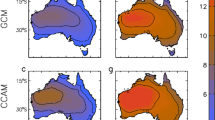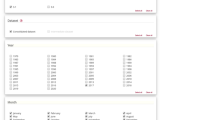Abstract
The most appropriate indices with which to quantify Australian bushfire danger are the McArthur fire danger meters. These meters use meteorological information to produce a fire danger index that is directly related to the chance of a fire starting - and to the severity of a fire once it has started. The Mark 5 forest-fire danger meter uses air temperature, relative humidity and wind speed, plus a drought factor that is calculated using daily rainfall and temperature information.
Three years of daily data generated from the CSIRO four-level general circulation model, and thirty years of daily data generated from the CSIRO nine-level model were used to estimate the daily McArthur forest fire danger index for simulations corresponding to present conditions, and to those corresponding to doubled atmospheric CO2. The performance of these models with respect to fire danger was tested by comparing the fire danger index for Sale (in the Eastern part of Victoria, South-eastern Australia) calculated from analysis of daily climatological data with the modelled annual cumulative forest fire danger index for the grid point that was representative of Sale. Data from both models for all Australian grid points were also examined. Both models predict an increase in fire danger over much of Australia for their doubled CO2 scenarios.
The results from the models confirm that annually averaged daily relative humidity is the single most important variable in the estimation of forest fire danger on an annual basis, yet the models tend to produce relative humidities that are slightly too low so that the fire danger is overestimated. A simple one-box model of evaporation indicates that the value of relative humidity to be expected under an altered climatic regime depends on the modelled relation between actual and potential evaporation, the present values of relative humidity and evaporation rate, as well as on the expected changes in wind speed.
Similar content being viewed by others
References
Alexander, M. E.: 1992, ‘The Keetch-Byram Drought Index: A Corrigendum’,Bull. Am. Met. Soc. 73, 61.
Australian Water Resources Council: 1970,Evaporation from Water Storages, Hydrological Series No. 4, Department of National Development, Canberra, Australia.
Balling, R. C., Jr., Meyer, G.A., and Wells, S. G.: 1992, ‘Climate Change in Yellowstone National Park: Is the Drought Related Risk of Wildfires Increasing?’,Clim. Change 22, 35–45.
Beer, T.: 1990,Applied Environmetrics Meteorological Tables, Applied Environmetrics, Balwyn, p. 46.
Beer, T.: 1991a,Applied Environmetrics Hydrological Tables, Applied Environmetrics, Balwyn, pp. 40–44.
Beer, T.: 1991b, ‘The Interaction of Wind and Fire’,Bound. Layer Met. 54, 287–308.
Beer, T., Gill, A. M., and Moore, P. H. R.: 1988, ‘Australian Bushfire Danger under Changing Climatic Regimes’, in Pearman, G. I. (ed.),Greenhouse: Planning for Climatic Change, CSIRO, pp. 421-427.
Brutsaert, W. H.: 1982,Evaporation into the Atmosphere, Reidel, Dordrecht.
Bultot, F., Dupriez, G. L., and Gellens, D.: ‘Estimated Annual Regime of Energy-Balance Components, Evapotranspiration and Soil Moisture for a Drainage Basin in the Case of a CO2 Doubling’,Clim. Change 12, 39–56.
Bureau of Meteorology (for Australian Water Resources Council): 1968,Review of Australia's Water Resources: Monthly Rainfall and Evaporation - Part 2, Maps, Bureau of Meteorology, Melbourne.
Fried, J. S. and Torn, M. S.: 1990, ‘Analyzing Localized Climate Impacts with the Changed Climate Fire Modeling System’,Natur. Resource Model. 4, 229–253.
Gill, A. M., Christian, K. R., Moore, P. H. R., and Forrester, R. I.: 1987, ‘Bushfire Incidence, Fire Hazard and Fuel Reduction Burning’,Aust. J. Ecol. 12, 299–306.
Gordon, H. B. and Hunt, B. G.: 1987, ‘Interannual Variability of the Simulated Hydrology in a Climatic Model - Implications for Drought’,Clim. Dynam. 1, 113–130.
Gordon, H. B.: 1981, ‘A Flux Formulation of the Spectral Atmospheric Equations Suitable for Use in Long-Term Climate Modelling’,Mon. Wea. Rev. 109, 54–56.
Keetch, J. J. and Byram, G. M.: 1968, ‘A Drought Index for Forest Fire Control’,USDA Forest Service Research Paper SE-38, Asheville, North Carolina (reprinted with corrections in 1988).
Lorenz, E. N.: 1967, ‘The Nature and Theory of the General Circulation of the Atmosphere’, World Meteorological Organization, Geneva.
Manabe, S. and Wetherald, R. T.: 1975, ‘The Effects of Doubling the CO2 Concentration on the Climate of a General Circulation Model’,J. Atmos. Sci. 32, 3–15.
McArthur, A. G.: 1966, ‘Weather and Grassland Fire Behaviour’,Commonw. Aust. For. Timber Bur. Leaflet 100.
McArthur, A. G.: 1967, ‘Fire Behaviour in Eucalypt Forest’,Commonw. Aust. For. Timber Bur. Leaflet 107.
McBean, G. A.: 1979,The Planetary Boundary Layer, Technical Note 165, World Meteorological Organization, Geneva, p. 42.
McGregor, J. L., Gordon, H. B., Watterson, I. G., Dix, M. R. and Rotstayn, L. D.: 1993,The CSIRO 9-Level Atmospheric General Circulation Model, Technical Paper 26, Division of Atmospheric Research, CSIRO, Australia.
Monteith, J. L.: 1981, ‘Evaporation and Surface Temperature’,Q. J. Roy. Met. Soc. 107, 1–27.
Noble, I. R., Bary, G. A. V., and Gill, A. M.: 1980, ‘McArthur's Fire-Danger Meters Expressed as Equations’,Aust. J. Ecol. 5, 201–203.
Robertson, G. W.: 1983,Weather-Based Mathematical Models for Estimating the Development and Ripening of Crops, Technical Note No. 180, (WMO-# 620), World Meteorological Organization, Geneva.
Sargent, G. P.: 1980, ‘Computation of Vapour Pressure, Dew Point and Relative Humidity from Dry and Wet Bulb Temperatures’,Met. Mag. 109, 238–246.
Shuttleworth, W. J.: 1983, ‘Evaporation Models in the Global Water Budget’, in Street-Perrott, A.et al. (eds.),Variations in the Global Water Budget, D. Reidel Publishing Co., Dordrecht, pp. 147–171.
Thom, A. S. and Oliver, H. R.: 1977, ‘On Penman's Equation for Estimating Regional Evaporation’,Q. J. Roy. Met. Soc. 103, 345–357.
Torn, M. S. and Fried, J. S.: 1992, ‘Predicting the Impacts of Global Warming on Wildland Fire’,Clim. Change 22, 257–274.
Whetton, P. and Pittock, A. B.: 1991,Australian Region Intercomparison of the Results of Some General Circulation Models Used in Enhanced Greenhouse Experiments, Tech. Paper 21, CSIRO Division of Atmospheric Research, Aspendale, Vic.
Whetton, P. H., Fowler, A. M., Haylock, M. R., and Pittock, A. B.: 1993, ‘Implications of Climate Change Due to the Enhanced Greenhouse Effect on Floods and Droughts in Australia’,Clim. Change 25, 289–317.
Whetton, P. H., Rayner, P. J., Pittock, A. B., and Haylock, M. R.: 1994, ‘An Assessment of Possible Climate Change in the Australian Region Based on an Intercomparison of General Circulation Modelling Results’,J. Clim. 7, 441–463.
Author information
Authors and Affiliations
Rights and permissions
About this article
Cite this article
Beer, T., Williams, A. Estimating australian forest fire danger under conditions of doubled carbon dioxide concentrations. Climatic Change 29, 169–188 (1995). https://doi.org/10.1007/BF01094015
Received:
Revised:
Issue Date:
DOI: https://doi.org/10.1007/BF01094015




